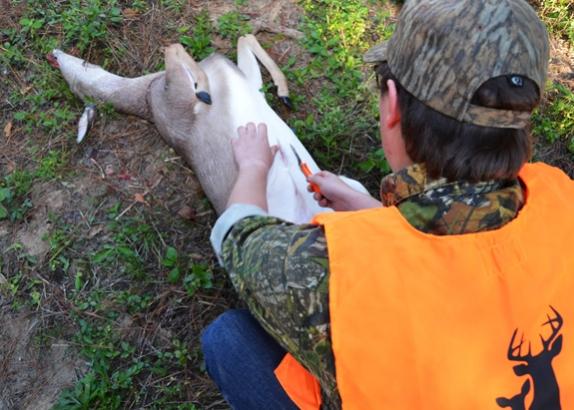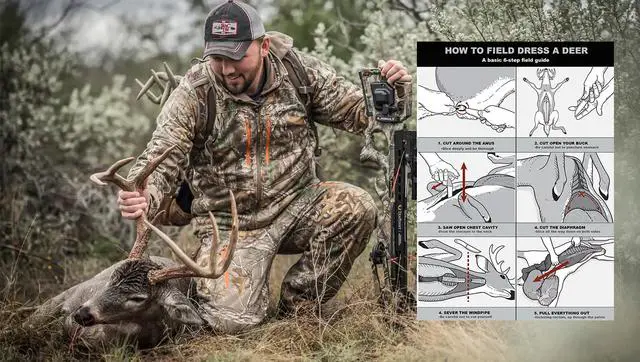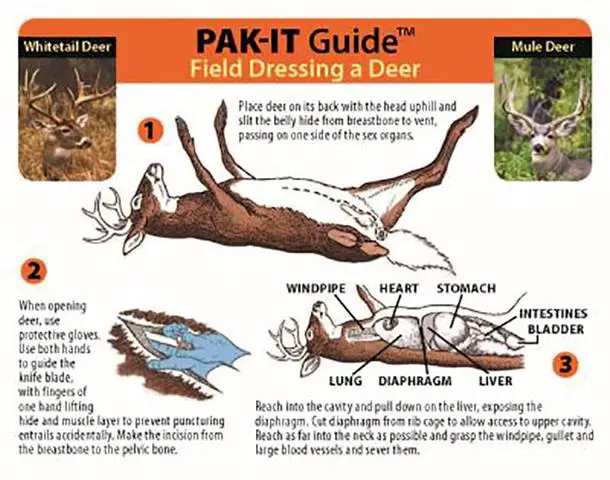“Field dressing a deer: Is immediate action necessary? Discover the essential insights and guidelines to determine if you must field dress a deer immediately or if there are alternative options. Maximize your hunting experience with expert advice and make informed decisions in the field.”
The Importance of Field Dressing a Deer Immediately After Harvest

Field dressing a deer immediately after harvest is crucial for maintaining the quality and taste of the meat. By removing the internal organs from the body cavity, this first step begins the process of cooling down the meat and preventing bacterial growth. It is recommended to perform field dressing as soon as possible after harvesting the animal, whether in the field or back at camp.
Proper Equipment
To effectively field dress a deer, it is important to have the right equipment. A good, sharp knife is essential for all phases of cleaning game animals. A sharp knife not only makes the work safer but also ensures better control over cuts. It is advisable to keep a sharpening device nearby to maintain the blade’s sharpness as needed. Additionally, wearing plastic gloves while cleaning game animals, especially feral hogs, is highly recommended to prevent disease transmission through any cuts or nicks on the hunter’s hands.
Cooling and Cleaning
After field dressing a deer, it helps to hang it to facilitate draining excess blood. Using a hose and water can aid in cleaning off any remaining blood; however, it is important to dry the animal thoroughly afterward as moisture contributes to bacteria growth. Skinning the deer further aids in cooling down the meat and should be done promptly after field dressing.
Quartering and Transportation
Once skinned, quartering becomes necessary for butchering the deer. This involves removing the forequarters (shoulders), hindquarters (hams), backstraps, neck trimmings, ribs, and chest cavity tenders. It is important to adhere to local hunting regulations regarding processing limitations before reaching your final destination.
To ensure that quartered deer meat remains cool and dry during transportation, place it in plastic bags inside an ice chest with added ice. It is crucial to retain tags and proper evidence of sex (head of a doe or antlers of a buck) for legal purposes. Transporting game animals on the hood or roof of cars should never be done, as it not only spoils the meat but also reflects poorly on hunters and may offend non-hunting individuals.
In conclusion, field dressing a deer immediately after harvest is vital for preserving the quality and taste of the meat. By following proper procedures, using the right equipment, and adhering to hunting regulations, hunters can ensure that their game is handled with care from field to table.
Why Prompt Field Dressing is Essential for Deer Meat Quality

Field dressing, which involves removing all the internal organs from the body cavity of a harvested animal, is crucial for preserving the quality of deer meat. This process should be done soon after harvesting the animal to begin the cooling down of the meat. By promptly field dressing the deer, you can prevent spoilage and maintain the freshness of the meat.
One of the main reasons why prompt field dressing is essential is to prevent bacterial growth. Bacteria thrive in conditions with heat, moisture, and dirt, which can easily contaminate the meat if not handled properly. By removing the internal organs and draining excess blood through hanging the deer, you reduce moisture and minimize bacterial growth.
To ensure hygiene and safety during field dressing, it is recommended to wear plastic gloves. This not only protects you from potential diseases or parasites transmitted by the animal’s blood but also prevents cross-contamination if you have any cuts or nicks on your hands. Carrying disposable gloves while hunting is convenient and helps maintain cleanliness throughout the process.
A sharp knife is an indispensable tool for field dressing game animals. A dull knife can lead to accidents and loss of control during cuts. Experienced hunters often keep a sharpening device nearby to maintain a sharp blade as needed. Using a sharp knife makes field dressing safer and easier.
After field dressing, it is important to hang the deer to facilitate drainage of excess blood. Cleaning off any remaining blood with water can be helpful but remember that moisture contributes to bacteria growth. Therefore, thoroughly drying off the animal is crucial before further processing.
Once hung and cleaned, skinning the deer aids in cooling down the meat further. Skinning removes another layer that could retain heat and contribute to spoilage. Additionally, quartering allows for easier transportation by separating forequarters, hindquarters, backstraps, ribs, neck trimmings, and tenders.
To maintain the quality of quartered deer meat, it is recommended to place the meat in plastic bags inside an ice chest. This keeps the meat cool and dry during transportation. It is essential to follow regulations regarding retaining tags and evidence of sex while transporting game animals.
Prompt field dressing not only helps preserve the quality of deer meat but also ensures hygiene and safety throughout the process. By following proper procedures and taking necessary precautions, you can enjoy a wonderful meal with family and friends, free from any complaints about “gaminess” that may arise from mishandling game after harvest.
Avoiding Gaminess: The Significance of Timely Field Dressing in Deer Hunting

When it comes to enjoying a delicious meal from the game you have hunted, proper care and handling of the meat is crucial. One of the main factors that can affect the taste and quality of the meat is gaminess, which can be traced back to how the game was handled after harvest. To avoid any complaints about gaminess at the table, it is important to understand the importance of timely field dressing.
Field dressing should be done as soon as possible after harvesting the animal. This process involves removing all the internal organs from the body cavity, which helps to start cooling down the meat. It is recommended to have an experienced hunter guide a novice in this procedure. Additionally, wearing plastic gloves during the cleaning process is highly recommended, especially when dealing with feral hogs or other animals that may carry diseases or parasites.
Having a good, sharp knife is essential for all phases of cleaning game animals. A sharp knife not only makes the work safer but also easier, as it reduces the likelihood of forcing the blade and losing control of the cut. Many experienced hunters keep a sharpening device nearby to touch up their blades as needed.
After field dressing, hanging the deer can facilitate draining any excess blood. It is also helpful to use water and a hose to clean off any excess blood, but it’s important to remember that moisture contributes to bacteria growth. Therefore, drying off the animal well is crucial.
Skinning the deer not only helps cool down the meat but also prepares it for further processing. Once skinned, quartering can be done by removing specific parts like forequarters (shoulders), hindquarters (hams), backstraps, and tenders from inside of chest cavity parallel to backstraps. However, according to Texas law, processing beyond quartering should only be done at your final destination.
To keep the quartered deer meat cool and dry, it is advisable to place it in plastic bags inside an ice chest. Adding ice will help maintain the desired temperature during transportation. It is important to retain the tags and proper evidence of sex (head of a doe or antlers of a buck) according to regulations.
Transporting game animals on the hood or roof of cars should be strictly avoided, as it not only spoils the meat but can also offend non-hunters. Proper disposal of feathers and entrails is essential to maintain cleanliness at hunting sites or motels.
When sharing game with others, hunters must fill out and sign a Wildlife Resource Document. Cleaning birds immediately after the hunt is recommended, but it is important to dispose of feathers and entrails properly. The attachment of one fully feathered wing or head is required while transporting dressed waterfowl or migratory game birds imported from Mexico.
Overall, timely field dressing plays a significant role in avoiding gaminess and ensuring a wonderful meal from your hunted game. Proper handling, using appropriate tools, and following regulations are key factors that contribute to enjoying high-quality meat with friends and family.
Proper Steps for Field Dressing a Deer to Preserve Meat Quality

Field dressing is a crucial step in preserving the quality of the meat after harvesting a deer. It involves removing the internal organs from the body cavity, which initiates the cooling down process of the meat. It is important to perform field dressing soon after harvesting the animal to prevent bacteria growth and spoilage. An experienced hunter should guide novices in this procedure to ensure it is done correctly.
Tools and Precautions
When cleaning game animals, especially feral hogs, it is recommended to wear plastic gloves. This helps prevent diseases or parasites from being transmitted through any cuts or nicks on the hunter’s hands. Disposable gloves are easily available at pharmacies and large supermarkets and can be carried conveniently while hunting. Additionally, using a sharp knife throughout the cleaning process makes the work safer and easier, reducing the risk of losing control of the cut.
Field Dressing Process
After field dressing, it is beneficial to hang the deer to allow excess blood to drain. Using a hose and water can help clean off any remaining blood, but it is essential to thoroughly dry the animal as moisture contributes to bacteria growth. Once hung, skinning the deer further aids in cooling down the meat.
Quartering and Storage
Quartering involves butchering the deer by removing its forequarters (shoulders), hindquarters (hams), backstraps, and other usable parts like neck trimmings and tenders inside the chest cavity. However, according to Texas law, you may not process beyond quartering until reaching your final destination. To keep your quartered deer meat cool and dry during transportation, place it in plastic bags inside an ice chest with some ice added.
Remember to retain tags and proper “evidence of sex” (head of a doe or antlers of a buck) as required by regulations. It is crucial never to transport game animals on the hood or roof of cars, as it can spoil the meat and offend non-hunters. Properly disposing of feathers and entrails is also important to maintain cleanliness at hunting sites and in town.
By following these proper steps for field dressing a deer, you can ensure the preservation of meat quality and avoid any complaints about “gaminess” during mealtime.
How Delayed Field Dressing Can Affect the Taste of Deer Meat

Delayed field dressing of deer meat can have a significant impact on its taste and quality. When an animal is harvested, the internal organs should be removed as soon as possible to begin the cooling down process. If field dressing is delayed, heat, moisture, and dirt can contribute to the growth of bacteria, which can spoil the meat and result in a gamy flavor.
One of the key factors in preserving the quality of deer meat is maintaining proper hygiene during field dressing. It is recommended to wear plastic gloves while cleaning game animals, especially feral hogs, to prevent the transmission of diseases or parasites through any cuts or nicks on the hunter’s skin. Disposable gloves are easily accessible and should be carried while hunting to ensure safe handling of the animal.
Using a sharp knife throughout the cleaning process is essential for both safety and ease. A sharp knife reduces the risk of forcing the blade and losing control during cuts. Experienced hunters often keep a sharpening device nearby to maintain the sharpness of their knife as needed.
After field dressing, it is beneficial to hang the deer to allow excess blood to drain off. Using water and a hose can help clean off any remaining blood, but it is important to thoroughly dry the animal afterward since moisture contributes to bacteria growth. Skinning the deer also aids in cooling down the meat.
Quartering, which involves removing specific parts like forequarters, hindquarters, backstraps, and tenders from the carcass, should only be done after reaching your final destination according to Texas law. The quartered deer meat should then be stored in plastic bags inside an ice chest to keep it cool and dry during transportation.
It is crucial not to transport game animals on car hoods or roofs as this can spoil the meat and may offend non-hunters who witness such disregard for animals. Following proper handling and transportation guidelines not only ensures the quality of the meat but also promotes a positive image of hunting among non-hunters.
By understanding the importance of timely field dressing and following proper cleaning and storage practices, hunters can ensure that the deer meat they harvest retains its optimal taste and quality for a delicious meal.
Ensuring Freshness: Why You Should Field Dress a Deer Right Away
Preventing Bacterial Growth
One of the key reasons why it is crucial to field dress a deer right away after harvesting is to prevent bacterial growth. The three factors that can spoil meat through the spread of bacteria are heat, moisture, and dirt. By field dressing the deer soon after harvesting, you begin the process of cooling down the meat and reducing the risk of bacterial contamination. This step involves removing all the internal organs from the body cavity, which helps to minimize the accumulation of heat and moisture in the carcass.
The Role of Proper Handling
Properly handling a harvested deer is essential in ensuring its freshness and taste. If corners are cut during this process, it can lead to regrets later on when complaints arise about “gaminess” at the dinner table. An experienced hunter should guide novice hunters in the field dressing procedure to ensure it is done correctly. It is also recommended to wear plastic gloves while cleaning game animals, especially feral hogs, as some diseases or parasites can be transmitted through any cuts or nicks on the hunter’s skin.
The Importance of Cooling Down
After field dressing, it is beneficial to hang the deer to facilitate draining any excess blood. Excess blood can contribute to bacterial growth, so using a hose and water to clean off any remaining blood is advisable. However, it is crucial to dry off the animal well afterward since moisture promotes bacteria growth. Additionally, skinning the deer helps further cool down the meat and maintain its freshness.
– Use plastic bags inside an ice chest to keep quartered deer meat cool and dry during transportation.
– Retain tags and proper evidence of sex (head or antlers) as required by regulations.
– Never transport game animals on car hoods or roofs as it can spoil the meat and offend non-hunters.
– When giving game to others, fill out and sign a Wildlife Resource Document.
– Dispose of feathers and entrails properly after cleaning birds.
– Use plastic gloves and game shears for cleaning birds.
– Two methods for cleaning birds: picking feathers with skin intact or “breasting” where the breast meat is separated from the rest of the body.
– Place cleaned birds in plastic bags inside a cooler with ice for transportation.
In conclusion, field dressing a deer immediately after harvesting is highly recommended. This practice not only ensures the preservation of the meat’s quality but also reduces the risk of spoilage and contamination. By removing the internal organs and cooling the carcass promptly, hunters can enjoy tastier venison while maintaining food safety standards.











































